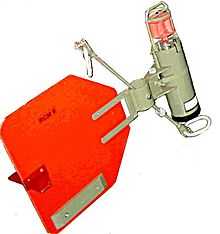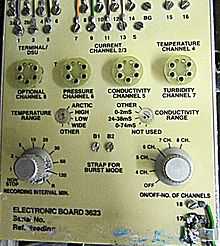Rotor current meter

A rotor current meter (RCM) is a mechanical current meter, an oceanographic device deployed within an oceanographic mooring measuring the flow within the world oceans to learn more about ocean currents. Many RCMs have been replaced by instruments measuring the flow by hydroacoustics, the so-called Acoustic Doppler Current Profilers. However, for instance in Fram Strait, the Alfred Wegener Institute still uses RCMs for long-term monitoring the inflow into the Arctic Ocean.[1]
Measurement principle

A RCM usually consists of the recording unit, a propeller to detect the water velocity and vane to determine the direction of the flow. The gimbal rings of the RCM-instruments allow to compensate a tilt of up to 40° of the mooring line.
The recording unit houses a battery pack for energy supply, the Analog-to-digital converter, possible additional sensors for other variables (like the standard parameters conductivity, temperature, depth, CTD) and a micro-controller. According to the data sheet of the instruments RCM 7/8,[2] the micro-controller performs the following tasks:
A built-in clock triggers the instrument at preset intervals and a total of six channels are sampled in sequence. The first channel is a fixed reference reading for control purposes and data identification. Channels 2, 3 and 4 represent measurement of temperature, conductivity and depth respectively. Channels 5 and 6 represent the vector averaged current speedand direction since the previous triggering of the instrument. The data is sequentially fed to the Data Storage Unit (DSU) 2990 or 2990E.
— RCM 7/8 Manual

The flow direction is detected by a magnetic compass, a needle clamped onto a potentiometer. This design becomes problematic for instruments in the Arctic Ocean since the North Magnetic Pole moves relative to the geographic North Pole and this (time-depended) magnetic declination cannot be neglected any more.
Data quality
Accuracy and precision of the RCMs are topic of an ongoing discussion. Comparative studies between different types of RCMs placed close to each other show that the instruments have large systematical errors.[3]
The following table summarizes the specification for various single-point current meters.[4]
| Instrument type | Measurement principle | Measurement error according to manual |
|---|---|---|
| Aanderaa RCM 7 | rotor | ±0.01 m/s or 4% (whatever is greater) |
| Aanderaa RCM 8 | rotor | ±0.01 m/s or 4% (whatever is greater) |
| Aanderaa RCM 9 | acoustic, single-point | ±0.0015 m/s |
| Aanderaa RCM 11 | acoustic, single-point | ±0.0015 m/s |
| Falmouth Scientific Instruments | state of the art ADCP | ±0.005 m/s |
These values only hold for medium currents between 0.02 and 2.95 m/s. Small velocities are difficult to detect because the vane shows a lot of inertia and the rotor needs to overcome friction before starting to rotate. The company Aanderaa calls the acoustical single-point instruments recording current meter which allows to keep the abbreviation RCM.
References
- ↑ Beszczynska-Möller, Agnieszka; Woodgate, Rebecca; Lee, Craig; Melling, Humfrey; Karcher, Michael (1 September 2011). "A Synthesis of Exchanges Through the Main Oceanic Gateways to the Arctic Ocean". Oceanography 24 (3): 82–99. doi:10.5670/oceanog.2011.59.
- ↑ "Recording Current Meter RCM7 & RCM8" (PDF). Data Sheet D 197. Aanderaa Instruments. Retrieved 26 September 2012.
- ↑ Hogg, Nelson G.; Frye, Daniel E. (1 February 2007). "Performance of a New Generation of Acoustic Current Meters". Journal of Physical Oceanography 37 (2): 148–161. doi:10.1175/JPO3003.1.
- ↑ Behrendt, Axel. "Comparison of the Current Field in Fram Strait derived from ADCP Measurements and Mooring Data" (PDF). Master Thesis. Postgraduate Programme Environmental Physics. Retrieved 26 September 2012.
External links
- Aanderaa's Recording Current Meters (RCM-9 + RCM-11) are no longer working mechanically, but their ancestors RCM-7 did, see Arctic Marine Engineering-Geological Expeditions: Oceanographic equipment
- Falmouth Scientific's Point Velocity Acoustic Current do no longer include any Rotor Current Meter.
- The German Shipping Museum in Bremerhaven exhibits a large collection of mechanical current meters.